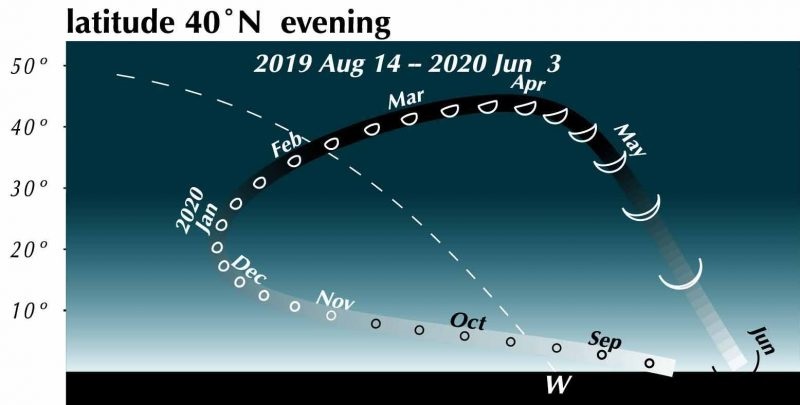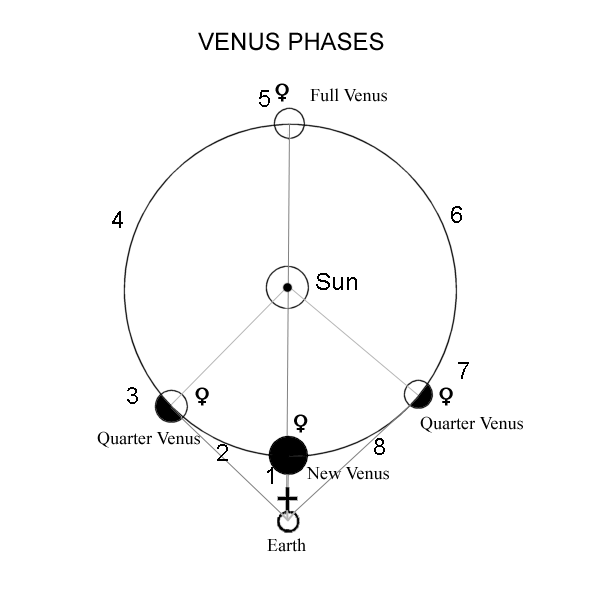VENUS STEALS THE SHOW
Perhaps some of you followed the Venus-Jupiter gathering in the latter part of November, when the two brightest planets hung side by side low in the southwestern sky after sunset. Since then, the two planets have seemed to go in opposite directions, with Jupiter disappearing from view as it appears more and more on the far side of the Sun, while Venus has been rising ever higher.
This improvement in Venus’ visibility will be obvious during December. As can be seen from the chart below, Venus’ height above the horizon at sunset will almost double this month, and then, but by bit, almost double again by the time of its peak in March and April. What is happening? First of all, Venus is leaving the Earth behind in the never-ending race around the Sun, changing from almost between Earth and Sun to appearing almost as far away from our star as can be. The other factor is due to Earth’s axis being tilted relative to the plane of the planets in our solar system. This plane appears in the sky as the line of the ecliptic or Zodiac. During fall evenings, the ecliptic follows a shallow angle from the southwestern horizon, causing Mercury and Venus to appear low in the sky, usually dimmed by twilight. The angle of ecliptic to horizon improves steadily through the winter and it at its highest in the spring. Thus Venus will soar ever higher, and will set as late as 11:30 pm this April, dominating the night skies.

This picture, used with permission from Guy Ottewell, shows Venus’ position in the sky at sunset on the 4th, 14th, and 24th of each month. To the unaided eye, Venus always appears as a brilliant “star”- its size and shape as shown here are as seen with a small telescope. Good binoculars can resolve Venus’ crescent phase during May.
Venus’ cloudy atmosphere reflects the Sun’s light very well, and being an inner planet, it receives a lot of light from the Sun, in fact almost twice as much as the Earth does. It also is usually the nearest planet to Earth. All of these factors cause Venus’ brilliance in the sky. At its best, when seen in a dark background sky, Venus outshines any other planet by at least three times and any star by ten times. At peak brilliancy, if you can carefully shield yourself from any other light, you may notice that Venus is bright enough to cast a shadow!
The moon will appear in the vicinity of Venus around the 26th-28th of each month, December-April. This is always a good photo opportunity with a steadily held or tripod mounted camera. If you can, try a slightly longer exposure to reveal the outline of the “dark” part of the Moon, lit faintly by sunlight reflecting off the Earth onto the Moon. Venus will appear close to much dimmer Saturn Dec. 10-12, and points the way to sometimes elusive Mercury, far below Venus about 45-60 minutes after sunset in early February. Finally, in the last days of this long apparition, Venus will shine very close to Mercury May 21-22, with the Moon passing it one last time May 23-24.

This image shows how Venus’ orientation relative to the Earth changes, causing it to show moonlike phases. Venus will be near position 6 in early winter, 7 at the end of March, and 8 in May. It will pass just above the Earth-Sun line on June 3 (position 1) and will then move into the morning sky. Like the Moon, Venus appears half full at “Quarter” phase.
Although a spectacular sight to the naked eye, Venus is usually much less so when seen in a telescope, appearing as a featureless, small disk. The only thing that can be easily seen is Venus’ phase, which will very slowly slim down from nearly full in early winter to half at the end of March. As it passes more and more between the Earth and Sun, Venus will grow rapidly in apparent size in April and May, while at the same time sporting an ever thinner crescent, which might be resolved in good binoculars in May. This is the best time to view Venus with telescopes, and the April and May editions of this blog will feature its close pass to the Seven Sisters star cluster and Venus’ dramatic departure from our evening skies. January, however, will feature a certain famous hunter.
